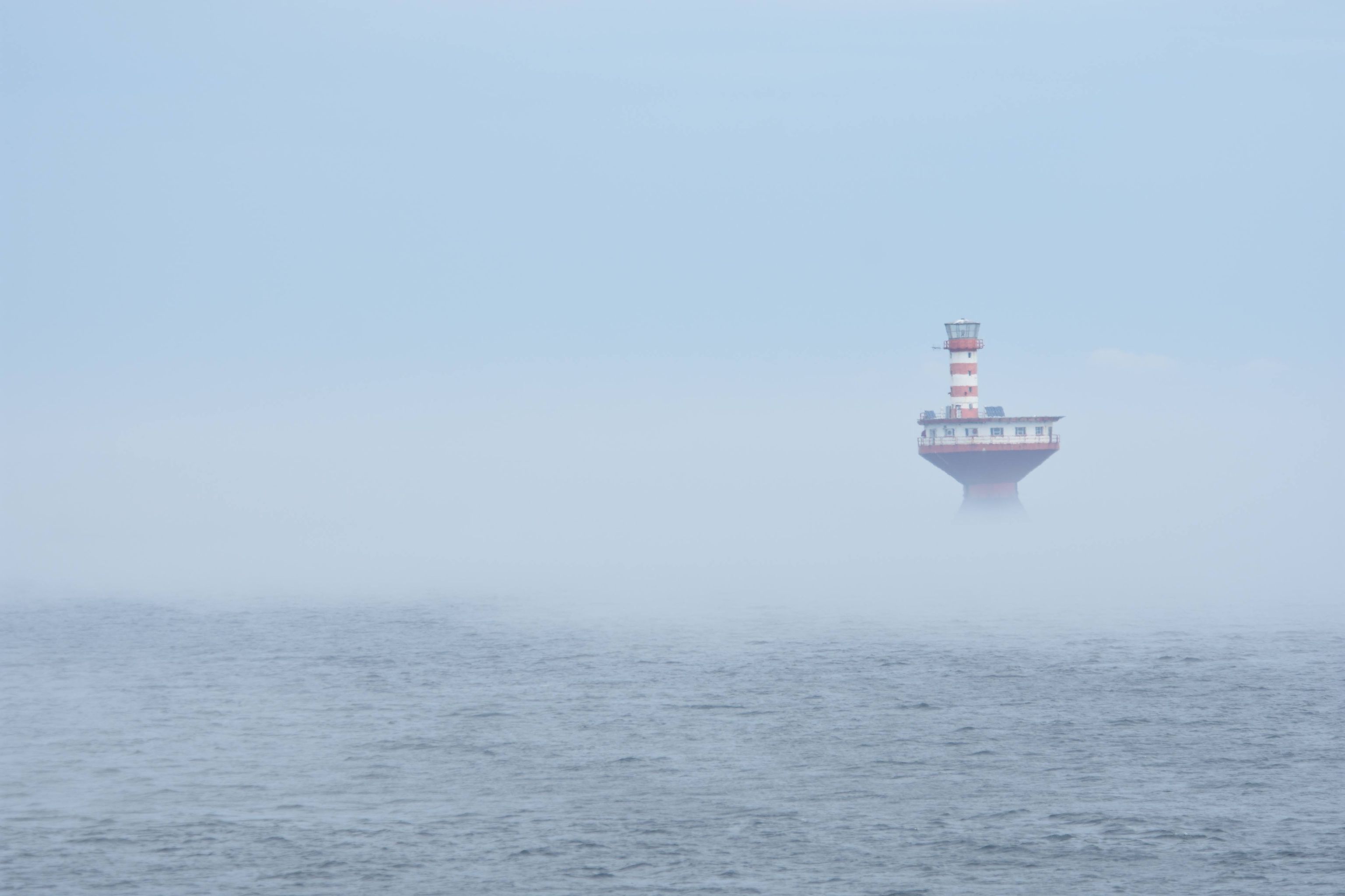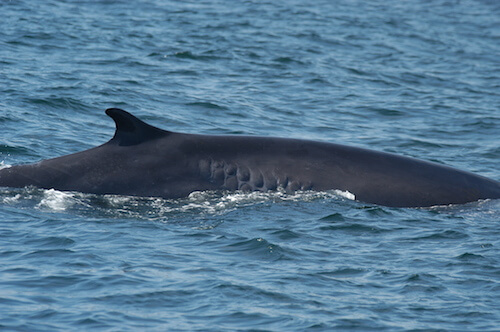“It’s tough to find a good weather window this week!” rants René Roy, collaborator for the Mingan Island Cetacean Study (MICS). Between the waves, the rain and the shroud of fog that seems to be taking up residence in the St. Lawrence Estuary, observers have been facing a number of challenges. But their patience has on occasion paid wonderful dividends.
On Tuesday, René takes advantage of the relatively mild weather to set sail between Matane and Pointe-des-Monts and spots… his first blue whale of the season! “It was impossible to identify… We were far offshore in a thick fog and heavy boat traffic, so I couldn’t really spend much time with it,” he confides. But oh how exciting to witness the return of these incredible giants to the Estuary. A few hours later, near Matane, he is treated to another magical spectacle: the migration of a hundred or so belugas to waters farther upstream. For half an hour, the St. Lawrence is speckled with white backs as far as the eye can see. It is rare to observe such an important congregation.
The same day, aboard a small boat off the coast of Les Bergeronnes, photographer Renaud Pintiaux follows a humpback whale through the mist, hoping he’ll have a chance to photograph it. Suddenly, offshore, the fog lifts, the sun beams down, and the animal raises its massive white pectoral fins toward the blue sky. The humpback performs an aerial ballet for several minutes, rolling in the water and slapping its fins on the surface. This individual is well known to researchers: her name is Chewbacca, and this is the first time she has been identified this year in the Marine Park.
Belugas in the mist or in the bay
In Cacouna and Rivière-du-Loup, belugas have also been present in good numbers every day, approaching the shoreline and coming to feed near the docks. Every day… or almost! “This week, there were three days when the fog was so thick that visibility was reduced to just a few hundred metres. We could hear the whales blowing, but we couldn’t see a thing!” points out one observer from the Marine Mammal Observation Network (MMON). “And on Sunday, there were so many waves, it was impossible to differentiate their white backs from the foam!”
But if you don’t go see the belugas, the belugas will come to you! On Sunday, June 27, about three hours after the tide had begun to rise, a group of 70 to 80 belugas enter Tadoussac Bay and frolic there for about 10 minutes, swimming in every direction. Some approach to within 20 metres of the docks and 100 metres from the beach, much to the surprise of local residents, who claim to never have seen them so daring. The most observant amongst them note that the cormorants are returning from their dives with small capelin in their bills. That probably explains it!
Out near the Mingan Islands, many minke whales are reported, as is an unidentified juvenile humpback. An observer posted at Pointe-des-Monts sums up his week: two humpbacks on Saturday, multiple minke whales and a handful of grey seals. On June 25, in Baie-des-Sables, a minke whale comes to feed about 300 metres from the end of the wharf. “It spent a good 15 minutes in front of me, wriggling from left to right. It’s always nice to watch them glide across the water, disappear for a few seconds and then reappear,” tells one observer.
Bounty in the Gaspé
Every morning at dawn, Gaspé-based captain Jean Roy sets out in pursuit of whales from Cap Bon-Ami. Once again this week, he is impressed by the number of large rorquals present. “There are hordes of sand lance along the coast. And in these schools of fish, I counted one morning up to 25 humpbacks and fin whales mixed together!” On Friday, an observer posted at the same location spots thousands of birds in the middle of a feeding frenzy. She patiently waits for whales to join the feast and is rewarded with two exquisite breaches.
Amongst these dorsal and caudal fins swarming around the tip of the Gaspé, rumours have it that some observers might have recognized the humpback whale BBR, also known as Gaspar, accompanied by a calf! This would be the second offspring of this faithful visitor to the Estuary, who has been known to researchers ever since she was born in 2005.
The Percé region is also brimming with activity. On June 23, three humpbacks are spotted 200 metres from Percé Rock. “They circled around us for over an hour,” confirms a tour boat captain. “There were also two fin whales near the buoy at the entrance to Percé, as well as five minke whales and a good number of seals.”
The river's teeth
On June 26, a water scooter enthusiast enjoys an impressive encounter. While riding off the coast Grande-Vallée, he spots a triangular fin emerge from the water. Below his motor, he can distinctly make out a basking shark passing by, its mouth agape. Measuring approximately 10 metres long, the basking shark is the second largest shark in the world. It is also a filter feeder that feeds on plankton, much like a whale. The basking shark is one of seven species of sharks found in the St. Lawrence. Learn more on the St. Lawrence Shark Observatory website.
Where are the whales this week?
These observations give an idea of the presence of whales and do not represent the real distribution of whales in the St. Lawrence. Use them for fun!
Click on the whale or seal icons to discover the species, the number of individuals, additional informations or photos of the sighting. To enlarge the map, click on the icon in the upper right corner. The map works well on Chrome and Firefox, but not so well on Safari.
To display the list of sightings, click on the icon in the upper left corner.













